Italy is renowned for its iconic cities like Rome, Venice, and Florence, but the country is also brimming with lesser-known destinations that offer unique experiences away from the tourist crowds. These hidden gems showcase Italy’s rich history, diverse landscapes, and vibrant culture in a more intimate setting. Here’s an extensive guide to some of Italy’s off the beaten path destinations, complete with travel tips to make your journey unforgettable.
1. Matera, Basilicata
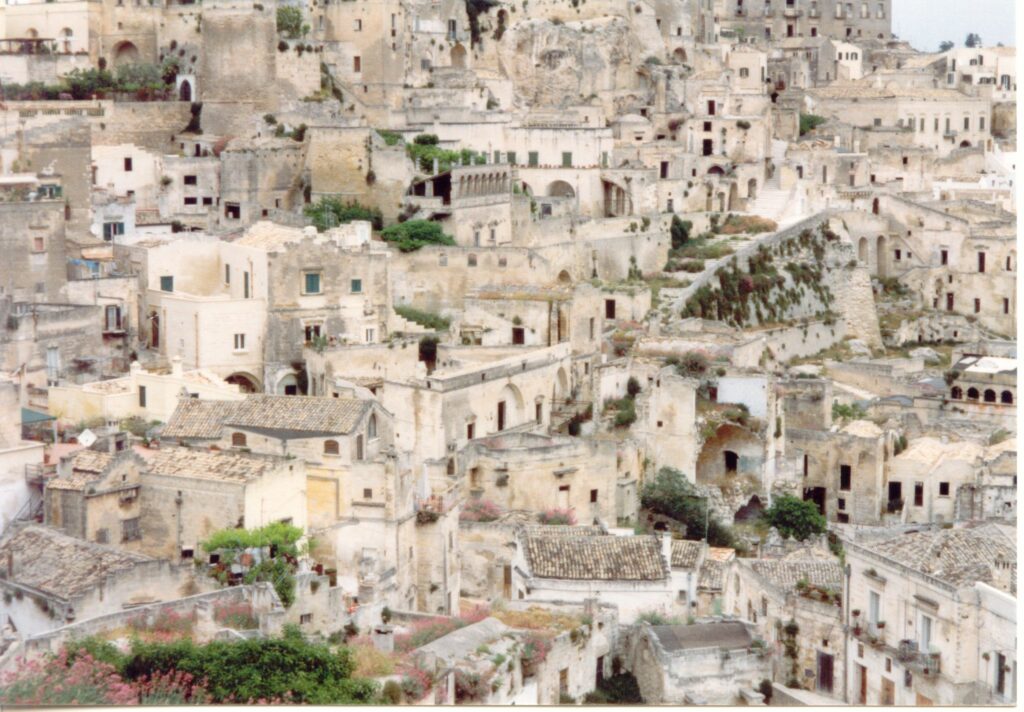 Matera, located in the southern region of Basilicata, is famous for its ancient cave dwellings known as “Sassi.” These prehistoric cave houses, carved into limestone cliffs, have been inhabited for thousands of years and are now a UNESCO World Heritage Site. Matera’s Sassi district consists of two main parts: Sasso Caveoso and Sasso Barisano. The labyrinthine streets, ancient stone houses, and rock-hewn churches create a unique and almost otherworldly atmosphere. The city has seen a renaissance in recent years, with many of the caves being restored and transformed into stylish hotels, restaurants, and museums. The Rupestrian Churches Park is a must-visit, showcasing rock churches adorned with frescoes from the 8th to 13th centuries.
Matera, located in the southern region of Basilicata, is famous for its ancient cave dwellings known as “Sassi.” These prehistoric cave houses, carved into limestone cliffs, have been inhabited for thousands of years and are now a UNESCO World Heritage Site. Matera’s Sassi district consists of two main parts: Sasso Caveoso and Sasso Barisano. The labyrinthine streets, ancient stone houses, and rock-hewn churches create a unique and almost otherworldly atmosphere. The city has seen a renaissance in recent years, with many of the caves being restored and transformed into stylish hotels, restaurants, and museums. The Rupestrian Churches Park is a must-visit, showcasing rock churches adorned with frescoes from the 8th to 13th centuries.
Tips for Travelers:
- Visit the Sassi: Explore the Sassi di Matera with a guided tour to understand the historical significance and see the well-preserved rock churches.
- Stay in a Cave Hotel: For a unique experience, stay in one of the many boutique cave hotels.
- Try Local Cuisine: Sample regional dishes like “orecchiette” pasta and “caponata.”
2. Orvieto, Umbria
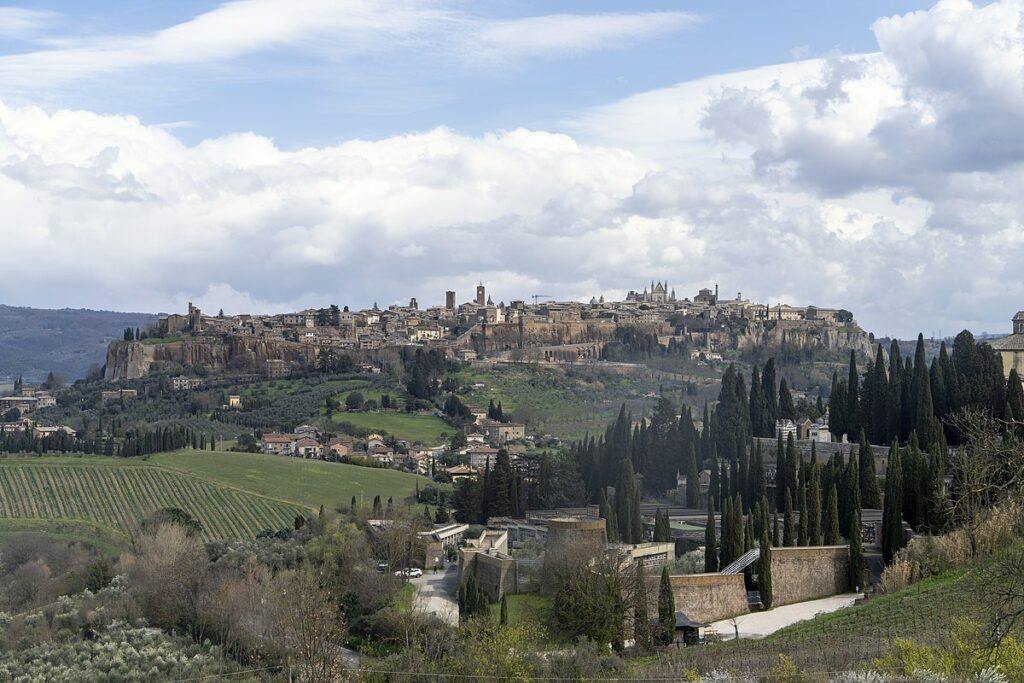 Perched atop a volcanic rock cliff, Orvieto in Umbria boasts stunning medieval architecture and a labyrinth of underground tunnels and caves. Orvieto’s dramatic position on a plateau made of tuff stone provides breathtaking views of the surrounding countryside. The town is known for its impressive Orvieto Cathedral, a masterpiece of Gothic architecture with a façade adorned with intricate mosaics and sculptures. Orvieto’s underground network, known as the Orvieto Underground, reveals a hidden world of ancient Etruscan caves, wells, and tunnels, showcasing the city’s long history.
Perched atop a volcanic rock cliff, Orvieto in Umbria boasts stunning medieval architecture and a labyrinth of underground tunnels and caves. Orvieto’s dramatic position on a plateau made of tuff stone provides breathtaking views of the surrounding countryside. The town is known for its impressive Orvieto Cathedral, a masterpiece of Gothic architecture with a façade adorned with intricate mosaics and sculptures. Orvieto’s underground network, known as the Orvieto Underground, reveals a hidden world of ancient Etruscan caves, wells, and tunnels, showcasing the city’s long history.
Tips for Travelers:
- Orvieto Cathedral: Admire the magnificent Orvieto Cathedral, renowned for its Gothic façade and stunning frescoes.
- Underground Tour: Take a tour of the underground city to explore ancient wells and Etruscan ruins.
- Wine Tasting: Enjoy Orvieto’s famous white wine at local vineyards and wine bars.
3. Lecce, Puglia
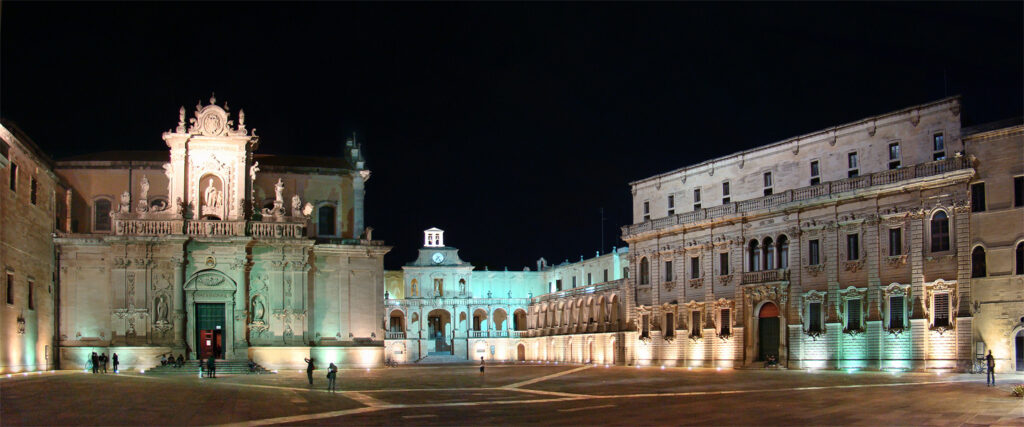 Often referred to as the “Florence of the South,” Lecce is a baroque masterpiece located in the Puglia region. Its stunning architecture and vibrant cultural scene make it a must-visit. Lecce’s historic center is a showcase of Baroque architecture, with churches and buildings intricately decorated with sculptures and carvings. The Basilica di Santa Croce is a prime example, with its ornate façade featuring mythological creatures and floral designs. The city’s Roman amphitheater, partially excavated and visible in Piazza Sant’Oronzo, adds to Lecce’s historical allure. Lecce is also known for its lively nightlife, bustling piazzas, and a thriving artisan community specializing in papier-mâché crafts.
Often referred to as the “Florence of the South,” Lecce is a baroque masterpiece located in the Puglia region. Its stunning architecture and vibrant cultural scene make it a must-visit. Lecce’s historic center is a showcase of Baroque architecture, with churches and buildings intricately decorated with sculptures and carvings. The Basilica di Santa Croce is a prime example, with its ornate façade featuring mythological creatures and floral designs. The city’s Roman amphitheater, partially excavated and visible in Piazza Sant’Oronzo, adds to Lecce’s historical allure. Lecce is also known for its lively nightlife, bustling piazzas, and a thriving artisan community specializing in papier-mâché crafts.
Tips for Travelers:
- Baroque Architecture: Wander through the city to marvel at baroque buildings like the Basilica di Santa Croce and Piazza del Duomo.
- Local Crafts: Discover the art of “papier-mâché” in local artisan workshops.
- Beach Excursions: Take a short drive to the beautiful beaches of the Salento Peninsula.
4. Trieste, Friuli Venezia Giulia
 Nestled between Italy and Slovenia, Trieste is a port city with a unique blend of Italian, Austrian, and Slavic influences. Its literary history and seaside charm are captivating. Trieste’s position as a major port city has shaped its eclectic character, combining elements of various cultures and architectural styles. The city’s grand waterfront, Piazza Unità d’Italia, is lined with impressive neoclassical buildings and offers stunning views of the Adriatic Sea. Trieste has a rich literary heritage, being home to writers like James Joyce and Italo Svevo. The historic Caffè San Marco, where these literary figures once gathered, remains a popular spot. The city’s cultural diversity is also reflected in its cuisine, with a mix of Italian, Austrian, and Slovenian influences.
Nestled between Italy and Slovenia, Trieste is a port city with a unique blend of Italian, Austrian, and Slavic influences. Its literary history and seaside charm are captivating. Trieste’s position as a major port city has shaped its eclectic character, combining elements of various cultures and architectural styles. The city’s grand waterfront, Piazza Unità d’Italia, is lined with impressive neoclassical buildings and offers stunning views of the Adriatic Sea. Trieste has a rich literary heritage, being home to writers like James Joyce and Italo Svevo. The historic Caffè San Marco, where these literary figures once gathered, remains a popular spot. The city’s cultural diversity is also reflected in its cuisine, with a mix of Italian, Austrian, and Slovenian influences.
Tips for Travelers:
- Piazza Unità d’Italia: Visit one of Europe’s largest seafront squares.
- Literary Tour: Follow the footsteps of famous writers like James Joyce and Italo Svevo.
- Coffee Culture: Experience Trieste’s rich coffee culture at historic cafes like Caffè San Marco.
5. Parma, Emilia-Romagna
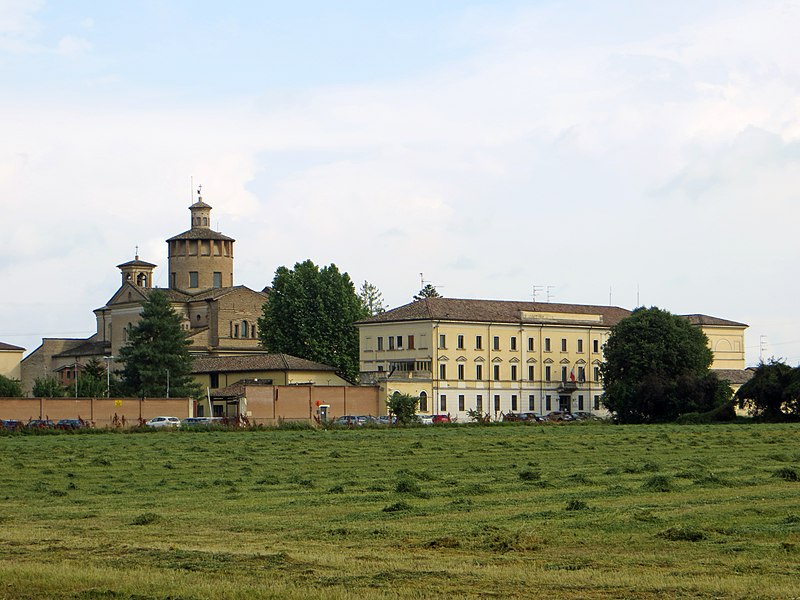 Parma is a food lover’s paradise, known for its Parmesan cheese and Parma ham. The city also boasts beautiful architecture and a vibrant cultural scene. Parma is synonymous with culinary excellence. The city is home to the renowned Parma ham (prosciutto di Parma) and Parmigiano-Reggiano cheese, both celebrated worldwide for their quality and flavor. The city’s historic center features elegant architecture, including the stunning Baptistery of Parma, a pink marble octagonal building with impressive frescoes. The Teatro Regio, one of Italy’s most prestigious opera houses, reflects Parma’s rich musical heritage.
Parma is a food lover’s paradise, known for its Parmesan cheese and Parma ham. The city also boasts beautiful architecture and a vibrant cultural scene. Parma is synonymous with culinary excellence. The city is home to the renowned Parma ham (prosciutto di Parma) and Parmigiano-Reggiano cheese, both celebrated worldwide for their quality and flavor. The city’s historic center features elegant architecture, including the stunning Baptistery of Parma, a pink marble octagonal building with impressive frescoes. The Teatro Regio, one of Italy’s most prestigious opera houses, reflects Parma’s rich musical heritage.
Tips for Travelers:
- Culinary Tours: Take guided tours to see how Parmesan cheese and Parma ham are made.
- Ducal Palace: Explore the stunning Ducal Palace and its surrounding gardens.
- Teatro Regio: Attend an opera performance at the historic Teatro Regio.
6. Sardinia’s Villages
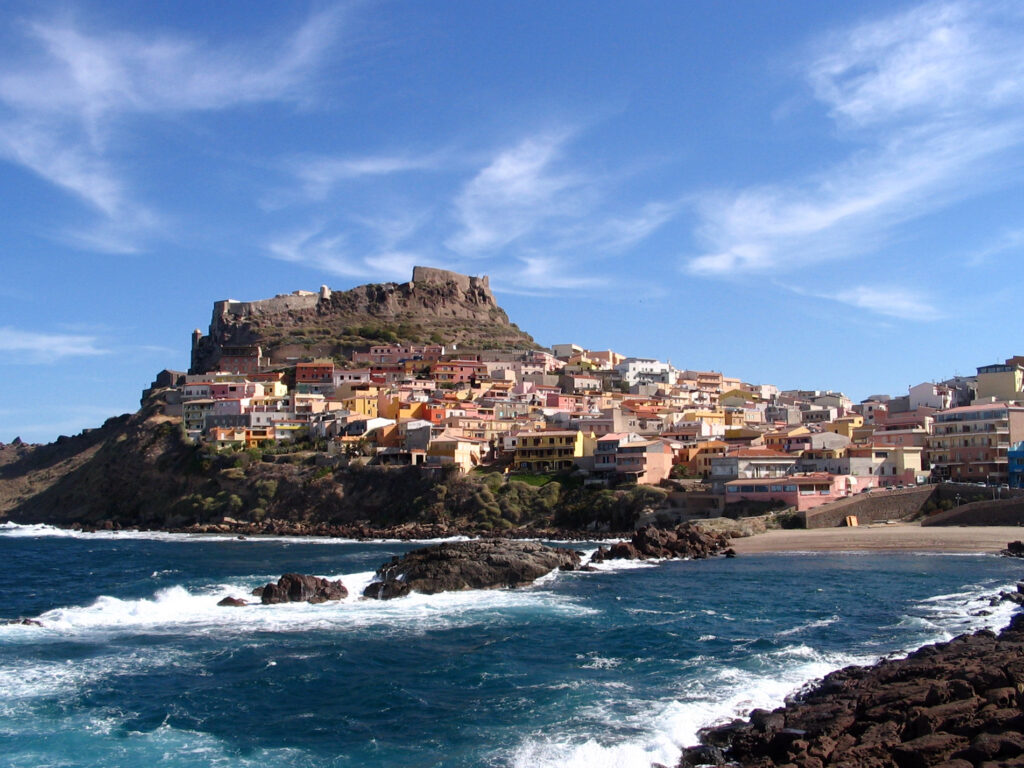 Beyond its famous beaches, Sardinia offers charming villages like Bosa and Castelsardo, rich in history and natural beauty. Sardinia’s interior villages offer a glimpse into the island’s traditional lifestyle and culture. Bosa, situated along the Temo River, is known for its colorful houses and the medieval Malaspina Castle, which offers panoramic views of the town and the river valley. Castelsardo, perched on a promontory overlooking the sea, features narrow streets, ancient fortifications, and a vibrant artisan community specializing in basket weaving. The town’s historic center is dominated by the Doria Castle, which houses the Museum of Mediterranean Weaving.
Beyond its famous beaches, Sardinia offers charming villages like Bosa and Castelsardo, rich in history and natural beauty. Sardinia’s interior villages offer a glimpse into the island’s traditional lifestyle and culture. Bosa, situated along the Temo River, is known for its colorful houses and the medieval Malaspina Castle, which offers panoramic views of the town and the river valley. Castelsardo, perched on a promontory overlooking the sea, features narrow streets, ancient fortifications, and a vibrant artisan community specializing in basket weaving. The town’s historic center is dominated by the Doria Castle, which houses the Museum of Mediterranean Weaving.
Tips for Travelers:
- Bosa: Stroll through the colorful streets of Bosa and visit Malaspina Castle for panoramic views.
- Castelsardo: Discover the medieval town of Castelsardo, known for its castle and traditional basket weaving.
- Local Festivals: Time your visit to coincide with local festivals for an authentic cultural experience.
7. Bologna, Emilia-Romagna
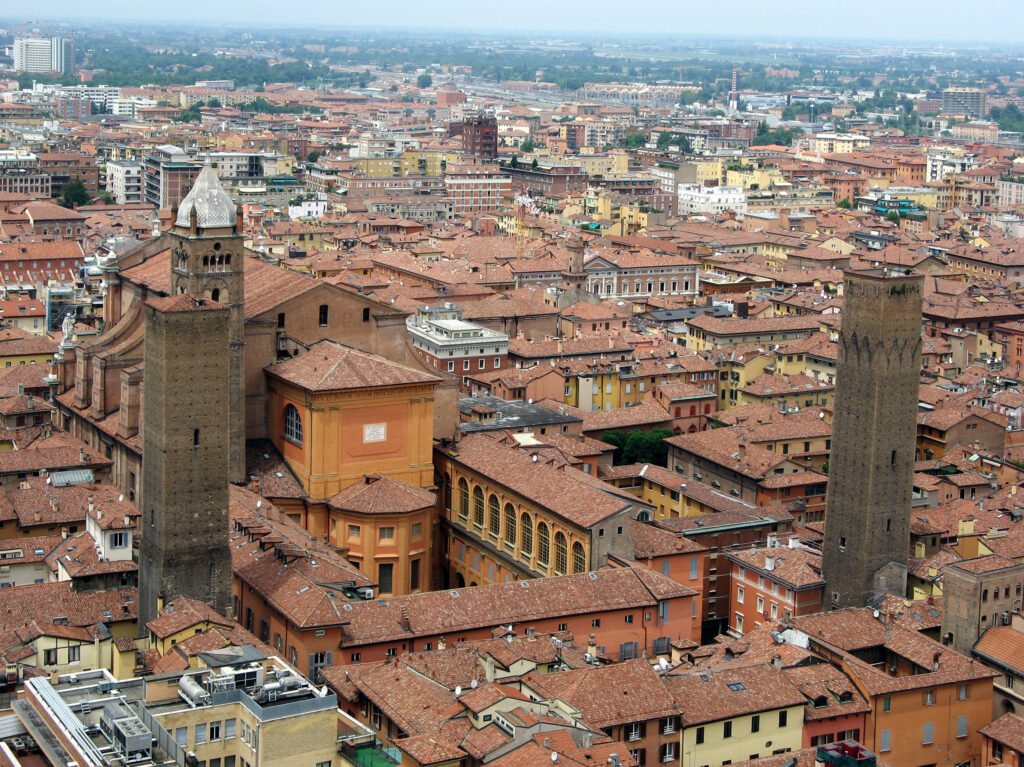 While not as hidden as others, Bologna remains less crowded compared to major tourist cities. Its medieval towers, porticoes, and culinary delights make it a must-visit. Bologna’s historic center is characterized by its extensive network of porticoes, which provide shelter and shade along the city’s bustling streets. The Two Towers, Asinelli and Garisenda, are iconic symbols of Bologna’s medieval heritage. The city is also home to the University of Bologna, the oldest university in the world, founded in 1088. Bologna’s culinary scene is legendary, with dishes like tagliatelle al ragù (Bolognese sauce) and mortadella being local specialties. The city’s vibrant markets, such as the Mercato di Mezzo, offer a taste of its rich food culture.
While not as hidden as others, Bologna remains less crowded compared to major tourist cities. Its medieval towers, porticoes, and culinary delights make it a must-visit. Bologna’s historic center is characterized by its extensive network of porticoes, which provide shelter and shade along the city’s bustling streets. The Two Towers, Asinelli and Garisenda, are iconic symbols of Bologna’s medieval heritage. The city is also home to the University of Bologna, the oldest university in the world, founded in 1088. Bologna’s culinary scene is legendary, with dishes like tagliatelle al ragù (Bolognese sauce) and mortadella being local specialties. The city’s vibrant markets, such as the Mercato di Mezzo, offer a taste of its rich food culture.
Tips for Travelers:
- Piazza Maggiore: Relax at the central square and visit the Basilica di San Petronio.
- Food Experience: Join a cooking class or food tour to taste local delicacies like tortellini and ragù alla Bolognese.
- University of Bologna: Explore the world’s oldest university and its historic buildings.
8. Bergamo, Lombardy
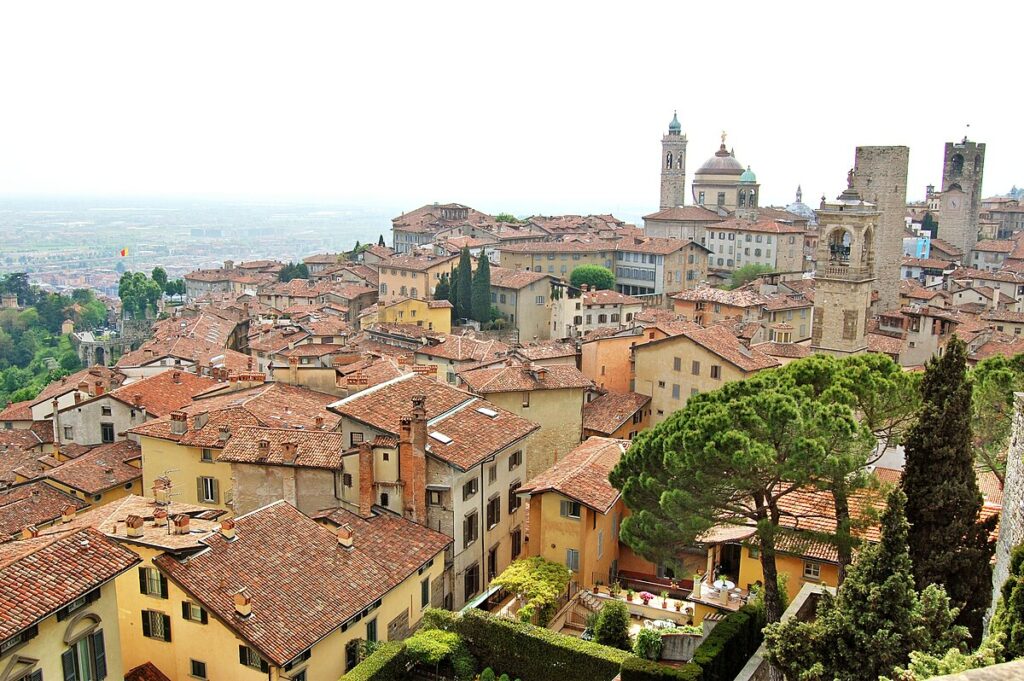 Bergamo, divided into the Città Alta (Upper City) and Città Bassa (Lower City), is a city of medieval charm and modern vibrancy. Bergamo’s Città Alta is a walled city perched on a hill, offering stunning views of the surrounding region. The Piazza Vecchia, the heart of the Upper City, is surrounded by historic buildings, including the Palazzo della Ragione and the Basilica di Santa Maria Maggiore. The Città Bassa, or Lower City, is more modern and lively, with elegant shopping streets and bustling squares. Bergamo is also known for its rich musical heritage, being the birthplace of composer Gaetano Donizetti. The city’s well-preserved architecture and cultural vibrancy make it a delightful destination.
Bergamo, divided into the Città Alta (Upper City) and Città Bassa (Lower City), is a city of medieval charm and modern vibrancy. Bergamo’s Città Alta is a walled city perched on a hill, offering stunning views of the surrounding region. The Piazza Vecchia, the heart of the Upper City, is surrounded by historic buildings, including the Palazzo della Ragione and the Basilica di Santa Maria Maggiore. The Città Bassa, or Lower City, is more modern and lively, with elegant shopping streets and bustling squares. Bergamo is also known for its rich musical heritage, being the birthplace of composer Gaetano Donizetti. The city’s well-preserved architecture and cultural vibrancy make it a delightful destination.
Tips for Travelers:
- Città Alta: Ride the funicular to the Upper City and explore its cobbled streets, ancient walls, and the Piazza Vecchia.
- Accademia Carrara: Visit one of Italy’s finest art galleries, housing works by Botticelli, Raphael, and Canaletto.
- Local Cuisine: Try the traditional dish “casoncelli,” a stuffed pasta, at local trattorias.
9. Ferrara, Emilia-Romagna
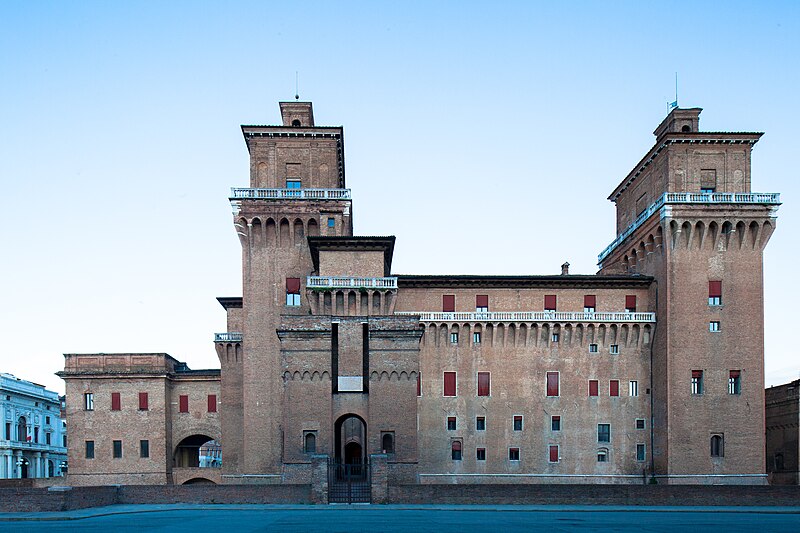 Ferrara, a Renaissance gem, is known for its well-preserved city walls, palaces, and rich cultural heritage. Ferrara’s historic center is a UNESCO World Heritage Site, recognized for its Renaissance urban planning and architecture. The Este Castle, surrounded by a moat and featuring impressive towers, is the city’s most prominent landmark. Ferrara’s streets are lined with elegant palaces, such as the Palazzo dei Diamanti, known for its distinctive diamond-shaped façade. The city’s cultural scene is vibrant, with numerous museums, art galleries, and festivals celebrating its Renaissance heritage. Ferrara is also known for its cycling-friendly streets, making it easy to explore by bike.
Ferrara, a Renaissance gem, is known for its well-preserved city walls, palaces, and rich cultural heritage. Ferrara’s historic center is a UNESCO World Heritage Site, recognized for its Renaissance urban planning and architecture. The Este Castle, surrounded by a moat and featuring impressive towers, is the city’s most prominent landmark. Ferrara’s streets are lined with elegant palaces, such as the Palazzo dei Diamanti, known for its distinctive diamond-shaped façade. The city’s cultural scene is vibrant, with numerous museums, art galleries, and festivals celebrating its Renaissance heritage. Ferrara is also known for its cycling-friendly streets, making it easy to explore by bike.
Tips for Travelers:
- Este Castle: Explore the moated Este Castle, which dominates the city center.
- Bicycle Tour: Discover Ferrara’s flat, bike-friendly streets and surrounding countryside on a bicycle.
- Literary Legacy: Visit the house of Ludovico Ariosto, a renowned Renaissance poet.
10. Aosta, Aosta Valley
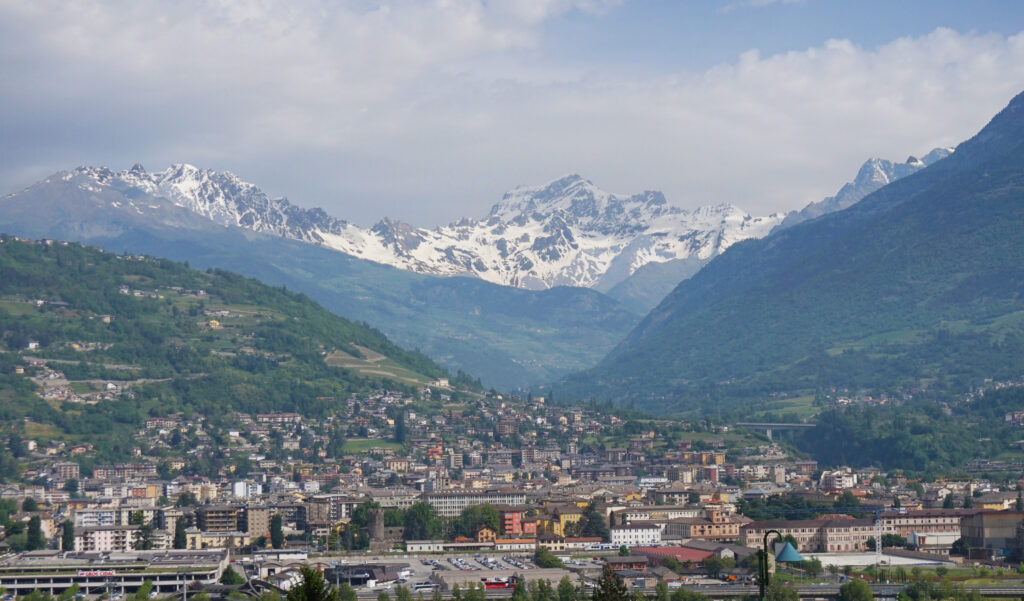 Aosta, nestled in the Italian Alps, is a city of Roman ruins and alpine beauty and the capital of the Valley, boasts a rich history dating back to Roman times. The city is home to several well-preserved Roman monuments, including the Arch of Augustus, the Roman theatre, and the city walls. Aosta’s picturesque streets are lined with medieval and Renaissance buildings, creating a charming atmosphere. The surrounding mountains offer numerous outdoor activities, from hiking and skiing to exploring the Gran Paradiso National Park, Italy’s first national park known for its stunning landscapes and diverse wildlife.
Aosta, nestled in the Italian Alps, is a city of Roman ruins and alpine beauty and the capital of the Valley, boasts a rich history dating back to Roman times. The city is home to several well-preserved Roman monuments, including the Arch of Augustus, the Roman theatre, and the city walls. Aosta’s picturesque streets are lined with medieval and Renaissance buildings, creating a charming atmosphere. The surrounding mountains offer numerous outdoor activities, from hiking and skiing to exploring the Gran Paradiso National Park, Italy’s first national park known for its stunning landscapes and diverse wildlife.
Tips for Travelers:
- Roman Ruins: Explore the Roman theatre, Arch of Augustus, and city walls.
- Gran Paradiso National Park: Enjoy hiking, wildlife spotting, and stunning scenery in Italy’s first national park.
- Ski Resorts: Visit nearby ski resorts like Pila for winter sports and mountain activities.
11. Urbino, Marche
 Urbino, a UNESCO World Heritage Site, is a hilltop town with a rich Renaissance history and vibrant cultural scene. It is is renowned for its contribution to art and culture. The Ducal Palace, built by Duke Federico da Montefeltro, is a masterpiece of Renaissance architecture and houses the National Gallery of the Marche, featuring works by artists like Raphael and Piero della Francesca. The town’s historic center is characterized by its steep, narrow streets and well-preserved buildings. Urbino is also a lively university town, adding to its vibrant atmosphere. The city’s scenic location atop a hill offers breathtaking views of the surrounding countryside.
Urbino, a UNESCO World Heritage Site, is a hilltop town with a rich Renaissance history and vibrant cultural scene. It is is renowned for its contribution to art and culture. The Ducal Palace, built by Duke Federico da Montefeltro, is a masterpiece of Renaissance architecture and houses the National Gallery of the Marche, featuring works by artists like Raphael and Piero della Francesca. The town’s historic center is characterized by its steep, narrow streets and well-preserved buildings. Urbino is also a lively university town, adding to its vibrant atmosphere. The city’s scenic location atop a hill offers breathtaking views of the surrounding countryside.
Tips for Travelers:
- Ducal Palace: Tour the Palazzo Ducale, home to the National Gallery of the Marche with works by Raphael and Piero della Francesca.
- University Town: Experience the lively atmosphere of this university town with its student population.
- Scenic Views: Enjoy panoramic views of the surrounding countryside from the town’s hilltop vantage points.
12. Trento, Trentino-Alto Adige
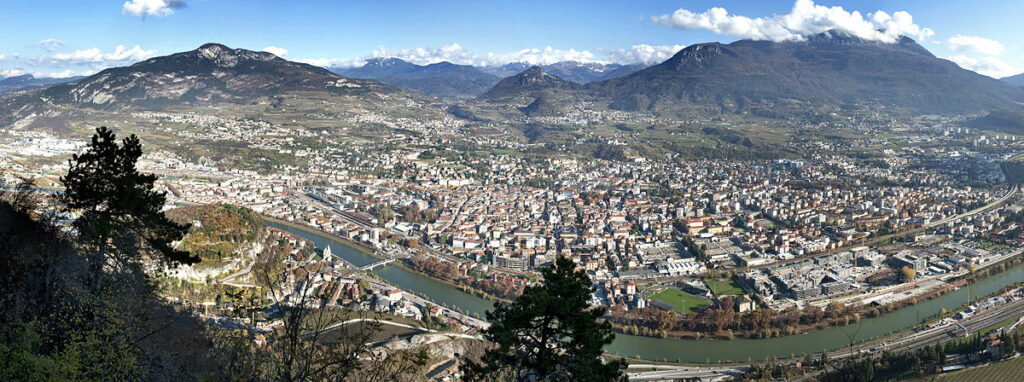 Trento, the capital of Trentino, is known for its blend of Italian and Austrian influences, reflected in its architecture and culture. Trento’s historic center is a delightful blend of Italian Renaissance and Austrian influences. The Buonconsiglio Castle, once the residence of the Prince-Bishops of Trento, is a major highlight with its impressive frescoes and towers. The city’s cathedral, Duomo di Trento, located in the main square, Piazza Duomo, is a stunning example of Romanesque-Gothic architecture. Trento is also known for the MUSE Science Museum, designed by renowned architect Renzo Piano, offering interactive exhibits that appeal to visitors of all ages. The nearby Dolomite Mountains provide ample opportunities for outdoor activities, making Trento an ideal base for exploring the region.
Trento, the capital of Trentino, is known for its blend of Italian and Austrian influences, reflected in its architecture and culture. Trento’s historic center is a delightful blend of Italian Renaissance and Austrian influences. The Buonconsiglio Castle, once the residence of the Prince-Bishops of Trento, is a major highlight with its impressive frescoes and towers. The city’s cathedral, Duomo di Trento, located in the main square, Piazza Duomo, is a stunning example of Romanesque-Gothic architecture. Trento is also known for the MUSE Science Museum, designed by renowned architect Renzo Piano, offering interactive exhibits that appeal to visitors of all ages. The nearby Dolomite Mountains provide ample opportunities for outdoor activities, making Trento an ideal base for exploring the region.
Tips for Travelers:
- Buonconsiglio Castle: Visit this impressive castle, which served as the residence of the Prince-Bishops of Trento.
- MUSE Science Museum: Explore the interactive exhibits at the MUSE, designed by renowned architect Renzo Piano.
- Dolomite Mountains: Use Trento as a base to explore the nearby Dolomite Mountains, ideal for hiking and skiing.
Practical Travel Tips for Italy’s Hidden Gems
1. Transportation:
- Rent a Car: For maximum flexibility, consider renting a car to explore remote areas and countryside.
- Local Trains: Use regional trains for an affordable and scenic way to travel between towns.
2. Accommodation:
- Boutique Hotels and Agriturismi: Stay in small boutique hotels or agriturismi (farm stays) for a more personal experience.
- Advance Booking: Book accommodations in advance, especially during peak seasons.
3. Dining:
- Local Eateries: Eat at local trattorias and osterias for authentic regional cuisine.
- Market Visits: Visit local markets for fresh produce, cheeses, and meats.
4. Cultural Etiquette:
- Dress Modestly: When visiting churches and religious sites, dress modestly.
- Learn Basic Italian Phrases: Knowing a few basic Italian phrases can enhance your travel experience and help you connect with locals.
5. Timing:
- Avoid Peak Season: Visit during the shoulder seasons (spring and fall) to avoid crowds and enjoy milder weather.
- Local Events: Check local event calendars to experience regional festivals and traditions.
Exploring Italy’s off the beaten path destinations offers a chance to see the country’s authentic side, away from the hustle and bustle of tourist hotspots. Each of these hidden gems provides unique insights into Italy’s diverse cultural and natural landscapes, promising unforgettable experiences for the intrepid traveler.










